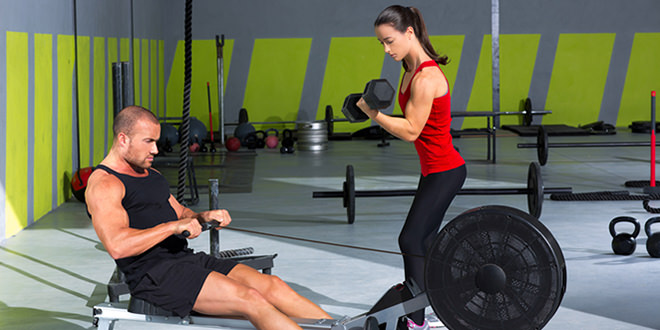Free weight exercises have long been labeled as the king of muscle building. Resistance machines are usually tagged to lose weight and tone muscles. But, are these long held beliefs fact or fiction?
There’s also a debate about what type of equipment is better for home use. Free weights can certainly take up much less space in your home when tucked away in a corner or closet. However, that very same equipment can also cause injury, even death over the safety offered by resistance machines.
The truth is that the right answer is different for everyone. Some people will benefit more from free weights. Other people will find they get more of what they want working out with machines.
So, which is really better? Let’s take a closer look at the pros and cons of both types of equipment.
Pros and Cons of Using Free Weights
There’s a definite argument for free weights being better at building muscle and offering a more ‘natural’ feel when it comes to lifting weights.
Pros:
- Free weights have been tested in various laboratory-based experiments and shown to help build both fast and slow twitch muscle fibers. Fast twitch fibers give us the explosive force needed to jump, sprint and perform various explosive sports. Slow twitch fibers offer strength and muscle endurance. This benefit is mostly because the exercises you can do are only limited by your imagination.
- Free weights encourage the development of small stabilizer muscles and ligaments which provide balance and prevent muscle, ligament, and joint tears during strenuous activity.
- Free weights are also easier to move around and store and don’t require much if any maintenance other than the occasional wipe-down.
Cons:
- Free weights require a certain level of fitness to use safely, as they don’t control the plane of movement, nor do they offer any backup if your muscles fail halfway through an exercise. Meaning the only sort-of-safe way to use them is with a spotter present.
- While they help to build more stabilizer muscles and ligament tissue, many free weight exercises place your muscles and joints in unstable positions that can lead to both short and long-term injuries that include back problems, muscle tears, and joint problems. In fact, a 17-year study found that 90% of all weight lifting injuries documented resulted from the use of free weights (source).
- Free weights are easier to move around, but at the same time they’re still bulky and cumbersome and require stands and racks to store them safely out of the way of children and pets in your home.
These facts aren’t meant to encourage or discourage the use of free weight exercises in your home gym. Rather, you need to look at the pros and cons of each, then compare them with the pros and cons of resistance machines listed below, to determine which will compliment your goals, lifestyle, and workout routine best.
Pros and Cons of Using Resistance Machines
While resistance machines are often passed off as feeling clunky and unnatural, and only to be used for toning muscle and shedding fat, things have changed over the last 10 – 20 years. Exercise science and technology are allowing modern machine exercises to catch up with their rugged free weight counterparts.
Pros:
- Resistance machines offer the reliability of a safe and predictable range of motion each and every time you use them. Fast and slow twitch muscle fibers can both be worked efficiently if you use enough resistance.
- Switching from one exercise to the next is easy with machines, often only requiring you to move a safety pin or two between exercises.
- No spotter is needed to use a resistance machine safely. Very few have attachments that can become dangerous if your hands or feet slip, or if your muscles fail during a movement.
Cons:
- Resistance machines can build plenty of strength, especially when using the commercial-rated equipment. Several home-rated machines offer limited resistance. This means you have to either pay more for heavier duty machines with more resistance, or watch your strength and muscle gains flat-line when you can’t increase the weight any higher.
- Machines have moving parts that can eventually fail and which require regular to semi-regular servicing including bearings, pulleys, cables and weight stacks. Following the manufacturer’s servicing schedule and/or buying equipment with free in-home maintenance and repair can help alleviate this problem.
- Users need to dedicate a substantial space in their home for most equipment (most space-saving Bowflex models excluded). Free weights can be moved around, including outside, and stowed away in a shed or dusty corner of a garage when not in use.
None of these pros or cons are a reason for everyone to want or not want to own and use a resistance machine. Not all of you will prefer the safety of a machine over the versatility of free weights. At the same time, modern machines require less maintenance than older machines and most people looking to buy a home gym usually have a large enough area in their home for its placement that space isn’t an issue.
So, What to Choose?
The answer is entirely up to you. All we can do is provide the most relevant information for you to make the decision that’s right for you and your family, available workout area, budget, and overall needs.
Take each of the pros and cons listed for both types of equipment under careful consideration, and then make a buying decision based on which offers the most benefits and the least disadvantages for you.
 Best Home Gym Reviews and Tips for Your Home Gym
Best Home Gym Reviews and Tips for Your Home Gym






